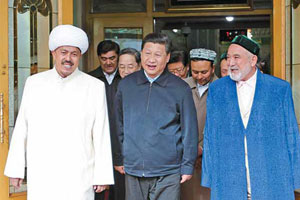Ministry issues draft to define smog-polluted day
Updated: 2014-05-13 21:51
By Cheng Yingqi (chinadaily.com.cn)
|
||||||||
The Ministry of Environmental Protection has for the first time defined what constitutes a smog polluted day.
In a recently released draft, the ministry indirectly states that the defining characteristic is PM2.5, particles smaller than 2.5 microns that can penetrate the lungs and seriously damage health.
The ministry published the draft on May 7 and will receive public feedback via phone (the number is 8610-66556214) by June 13.
According to the draft, the average visibility on a smog-polluted day is less than five kilometers for six or more consecutive hours due to high concentrations of fine particulate matter in the air.
A report by the Guangzhou Daily quoted an unnamed person from the ministry as saying the fine particulate matter in the definition refers mainly to PM2.5.
According to the ministry's new criteria, Guangzhou had 14 to 15 days of smog last year, and Beijing was shrouded in smog for 138 days. Shenzhen had no smog last year, under the criteria in the draft.
But according to a technical standard published by the China Meteorological Administration in 2010, if visibility is less than 10 km for reasons other than precipitation, a sandstorm or sand and dust, smog is the culprit. By this definition, Guangzhou saw 51 days of smog last year, according to the Guangzhou Daily.
The newspaper also quoted an unnamed insider as saying the ministry's criteria are too loose.
In November, the ministry published an instruction that urged local governments to establish emergency management systems against air pollution.
According to a report by people.cn, 38 cities across China prepared such emergency plans, with measures including shutting down polluting factories, employing temporary traffic restrictions and suspending classes at primary and middle schools.
Local governments in different regions have used various criteria to define smog because there was no official standard, which is why the ministry published the unified standard, it said.
Most Viewed
Editor's Picks

|

|

|

|

|

|
Today's Top News
Turkmen relations get horsepower
Stud-farm owner lauds stamina of horse breed
Beijing slaps polluting firm with highest fine
Suspect killed in Sichuan bus blast
Trip reflects militaries' will to seek closer ties
Russia says respecting choice of Donetsk, Lugansk
People in eastern Ukraine declare independence
Man detained for posting rumors
US Weekly

|

|















